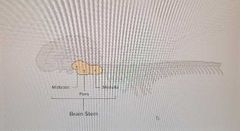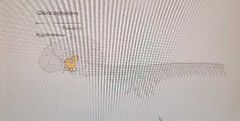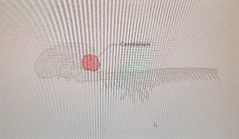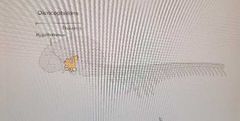![]()
![]()
![]()
Use LEFT and RIGHT arrow keys to navigate between flashcards;
Use UP and DOWN arrow keys to flip the card;
H to show hint;
A reads text to speech;
59 Cards in this Set
- Front
- Back
- 3rd side (hint)
|
A disease of white matter affecting ___ cells may cause difficulties with memory. |
Schwann cells (envelops and rotates around the axon forming myelin sheath) |
|
|
|
The conscious control of the skeletal muscles is referred to as ____ nervous system function. A. Sympathetic B. Autonomic C. Somatic |
Somatic |
|
|
|
____ impulses are carried by the dendrites toward the neuron cell body. Axons carry ___ impulses away from the cell body. |
Afferent (towards neuron) , efferent (away) |
|
|
|
A neuron ____ by opening sodium channels. This change in charge is known as ___ ___. |
Depolarize, action potential |
|
|
|
The brain stem forms the connection between brain and spinal cord and is composed of these three anatomic areas. |

Midbrain Pons Medulla oblongata |
|
|
|
The ____ connects the brain stem to the cerebrum. A. Cerebellum B. Midbrain C. Diancephalon |

Diancephelon |
|
|
|
The ____ ____ separates the capillaries in the brain from the nervous tissue, preventing substances from passing from the blood into the brain |
Blood-brain barrier |
|
|
|
The fibrous structure connecting the two halves of the brain. |
Corpus callosum |
|
|
|
The ___, dorsal to the brain stem, maintains balance, coordination, and complex reflexes. |

Cerebellum |
|
|
|
The three major components of the diancephelon. |

Hypothalamus, thalamus, pituitary |
|
|
|
Some sulfa drugs (), and other meds, are able to cross the ___ ____ and treat infections that may be occurring in the brain or meninges. |
Blood brain barrier |
|
|
|
An older dog that is having changes in behavior and having a hard time remembering where none objects are found. May be having a problem with which area of the brain? A. Frontal lobe B. Mid brain C. Cerebrum |
Cerebrum (The largest part of the brain, the cerebrum initiates and coordinates movement, speech, judgment, thinking and reasoning, problem-solving, emotions and learning.) |
|
|
|
Assessing the external effects of the twelve ____ ____ can give us insight until what may be going on inside the brain. A. Cranial nerves B. Lobes of the brain |
Cranial nerves (Olfactory nerve (CN I), optic nerve (CN II), oculomotor nerve (CN III), trochlear nerve (CN IV), trigeminal nerve (CN V), abducens nerve (CN VI), facial nerve (CN VII), vestibulocochlear nerve (CN VIII), glossopharyngeal nerve (CN IX), vagus nerve (CN X), accessory nerve (CN XI), and hypoglossal nerve (CN XII).) |
|
|
|
The ___ ____ is a merging of the axillary, radial, median, and ulnar nerves. A. Brain stem B. Brachial plexus C. Trigeminal nerve |
Brachial plexus (bundle of nerves that stems from nerve roots in the cervical (neck) and upper trunk (torso) sections of the spinal cord, creating a network that connects to the nerves in the arm.) |
|
|
|
The ___ ___ ___originates from the cranial and sacral aspects of the spinal cord and is differentiated by long, pre-ganglionic neurons. A. Parasympathetic nervous system B. Sympathetic nervous system C. Cranial sacral system |
Parasympathetic nervous system |
|
|
|
The stretch withdrawal and extensor reflexes are examples of ___ ___, or rapid, autonomic, nerve-to- nerve interaction to protect the body. |
Reflex arcs |
|
|
|
____ neurons carry signals such as touch and tasteto the brain, while ____ neurons carry signals from the brain to muscles. |
Sensory neurons, motor neurons |
|
|
|
The five general senses are ..... |
Visceral sensation, touch/tactile, temperature, pain, proprioception |
|
|
|
Sensory receptors respond to which four stimuli? |
Mechanical, thermal, electromagnetic, chemical |
|
|
|
The feeling of fullness in a hollow organ such as an empty/full stomach or bladder is an example of which sense? |
Visceral sense |
|
|
|
While superficial temperature receptors are in the skin, central temperature receptors are found within the ___ to monitor internal temperature of the body. |
Hypothalamus |
|
|
|
Pain receptors, also known as ______, are located everywhere in the body except the ___. |
Nociceptors, the brain |
|
|
|
The four processes of pain reception are.... |
1. Transduction 2. Transmission 3. Modulation 4. Perception |
|
|
|
During the transduction phase of pain processing, ____. |
Painful stimulus is converted to nerve impulse |
|
|
|
During the ___ phase of pain processing, the pain signal is relayed to the spinal cord. |
Transmission |
|
|
|
The pain phase, ____, occurs in the spinal cord and the pain will become more or less severe. |
Modulation |
|
|
|
Pain is classified in two ways: |
Location and chronicity |
|
|
|
An animal with poor perception of where it's limbs are in space is said to have a ___ deficit. This can mean a problem in which area of the brain? |
Proprioceptive, cerebellum |
|
|
|
Sense of taste is referred to medically as the ____ sense. |
Gustatory sense |
|
|
|
___ ___ is an exaggerated pain response if pain is left untreated. |
Wind up |
|
|
|
The vestibule and semi circular canals of the inner ear are involved in the complex process of ____. |
Equilibrium |
|
|
|
Nocturnal animals have a higher percentage of rods/cones than diurnal animals. |
Rods |
|
|
|
Animals with better color vision have more rods/cones than those with poorer color vision. |
Cones |
|
|
|
The area of the eye with the sharpest vision, and the largest concentration of rods and cones is the ___ ___. |
Area centralis |
|
|
|
The external ear is divided into these three components: |
Pinna, external auditory canal, and tympanic membrane |
|
|
|
The three, tiny bones (the auditory ossicles) of the middle, ear that deamplify sound waves as to not cause damage to the inner ear: |
Malleus (hammer), incus (anvil), stapes (stirrups) |
|
|
|
The bone of the middle ear, the ___, is the only one that contacts the ear drum. |
Malleus |
|
|
|
Upper respiratory tract infections can affect an animal's sense of ___, which can cause them to stop eating/ drinking and exacerbate the illness. |
Sense of smell |
|
|
|
The abnormal accumulation of free blood between the cartilage and skin of the pinna, often caused by excessive head-shaking as a result of an ear infection. Can cause deformity of left untreated. |
Ear hematoma |
|
|
|
The ___ ___ is the opening in the skull, leading from the middle ear to the inner. |
Oval/vestibular window |
|
|
|
The tiny muscle attached to the malleus. This muscle adjust the tension of the ear drum to soften the transmission of loud noises. |
Tensor tympani |
|
|
|
The tube that travels to the nasopharynx, keeping air pressure inside the ear consistent with outside the body. |
Eustachian tube |
|
|
|
The hearing portionof the inner ear is contained in the temporal bone called the ___. |
Cochlea |
Snail shape |
|
|
Within the cochlea is the ___, which contains the receptor hair cells that facilitate hearing. |
Organ of corti |
Long fancy name |
|
|
The eye consists of these three layers: |
Cornea, uvea, retina |
|
|
|
The function of saltatory conduction is to speed/initiate signal transmission along a neuron. |
Speed signal along a neuron |
|
|
|
The function of synaptic vescicles is to A. Contact the post synaptic membrane B. Insulate the axon C. Store neurotransmitters |
Store neurotransmitters |
|
|
|
A sensory nerve fiber would fit into which category: A. Cranial nerves B. Efferent nerves C. Afferent nerves |
Afferent (sensory nerves conduct FROM receptor TO the CNS) |
|
|
|
The cell body of the neuron where the nucleus is located: A. Dendrite B. Perikaryon C. Cyton |
Cyton |
|
|
|
Which of the following is NOT a general sense: A. Touch B. Vision C. Visceral sensation D. Proprioception |
Vision |
|
|
|
Which of the following are cranial nerves (more than one answer) : A. Optic B. Trochlear C. Brachial plexus D. Oculomotor |
A, b, and d |
|
|
|
The name for the gaps in the myelin sheath: A. Saltatory gaps B. Schwann cells C. Nodes of ranvier |
Nodes of ranvier |
|
|
|
The water refluid that fills the aqueous compartment of the eye. |
Aqueous humor |
|
|
|
A portion of the middle vascular layer of the eye consisting mainly of pigment and blood vessels. |
Choroid (a component of the uvea) |
A. Cornea B. Uvea C. Choroid |
|
|
The transparent membrane that covers the front portion of the eyeball. |
Conjunctiva |
Consists of the components and is the site of a commonly treated inflammatory illness |
|
|
The lateral corner of the eye where the upper and lower eyelids come together. |
Canthus |
A. Palpebra B. Canthus C. Conjunctiva |
|
|
The portion of the middle vascular layer of the eye located immediately behind the iris. It contains the muscles that adjust the shape of that lens. |
Ciliary body |
The muscles the adjust the lens are ciliary muscles |
|
|
A condition in which in movements becoming jerky and exaggerated. Caused by damage or disease involving the cerebellum. |
Hypermetria |
A. Hyperplasia B. Hypermetria C. Ataxia |
|
|
The set of connective tissue layers that surround the brain and the spinal cord. Consisting of 3 layers,These tissues supplies nutrients and oxygen. |
Meninges |
Affected by meningitis |

